NEPAL
Tightening Control
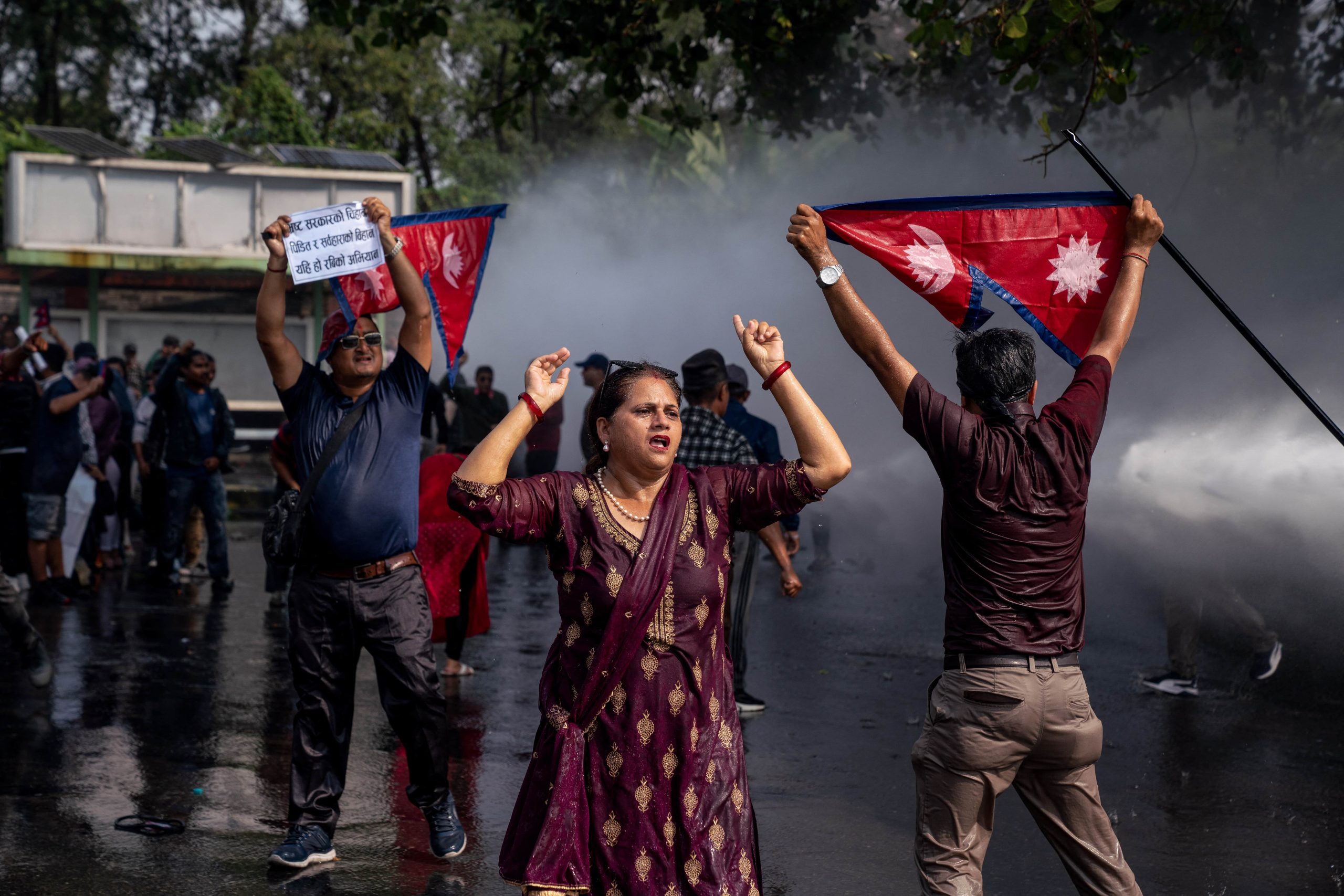
The Federation of Nepali Journalists (FNJ) and the Nepal Press Union (NPU) condemned the arrest of media tycoon Kailash Sirohiya as an abuse of power by the then-deputy prime minister Rabi Lamichhane. His arrest followed media investigations into Lamichhane’s alleged misappropriation of funds. Police use water cannons to disperse supporters of Lamichhane in Pokhara on October 20, 2024, protesting after his arrest on fraud and organised crime charges. Credit: Yunish Gurung / AFP
Amid political uncertainty and changing governments, the media industry and working journalists in Nepal continued to grapple with significant challenges in the period under review.
Despite some wins on journalists’ rights, the economic and employment conditions for media workers remain dire in the country. The issue of inadequate wages for journalists persisted, highlighting the failures of successive governments to fully implement the Working Journalists Act. Nepal’s unions actively urged the country’s new coalition government to take immediate action to increase minimum wages, ensure regular payments, and provide occupational and social security for journalists.
Under the new KP Sharma Oli coalition government, the year saw tightening control over the media in Nepal. Two bills – the Social Media Operation, Use and Regulation Bill, registered in the Upper House of Parliament on January 26, 2025, and the Media Council Bill passed by the Upper House on February 10, 2025 – are likely to have significant impact on the media.
The Artificial Intelligence (AI) concept paper, which was published in July 2024, is one of the first clear attempts to regulate AI that will have flow-on impacts within the country’s media sector. The regulation of social media and AI is quickly presenting new challenges not only for Nepal but also globally. So too, Nepal’s ongoing attempts to regulate social media not backed by proper research or consultations with stakeholders, continued to draw ire from advocates of freedom of expression. What happens in Nepal in the context of such regulation will no doubt be viewed beyond its borders as well as within.
Over the past year, journalists were killed, threatened, beaten and abused while performing their duties. The Federation of Nepali Journalists (FNJ) – an IFJ affiliate – recorded a total of 47 incidents of press freedom violations. Two journalists also lost their lives in tragic incidents while reporting in the line of duty.
The Vibrant Information Barometer study report, published in October 2024 by IREX and The Asia Foundation, concluded that the Nepali media landscape is currently “somewhat vibrant”. The country scored 23 out of 40 on the study’s four key measures: Information quality, channels, consumption and engagement, and transformative action. A panel of 30 experts evaluated the so-called vibrancy of Nepal’s media ecosystem based on 20 indicators with a further 167 sub-indicators.
Media Rights Violations
Killings
Arrests
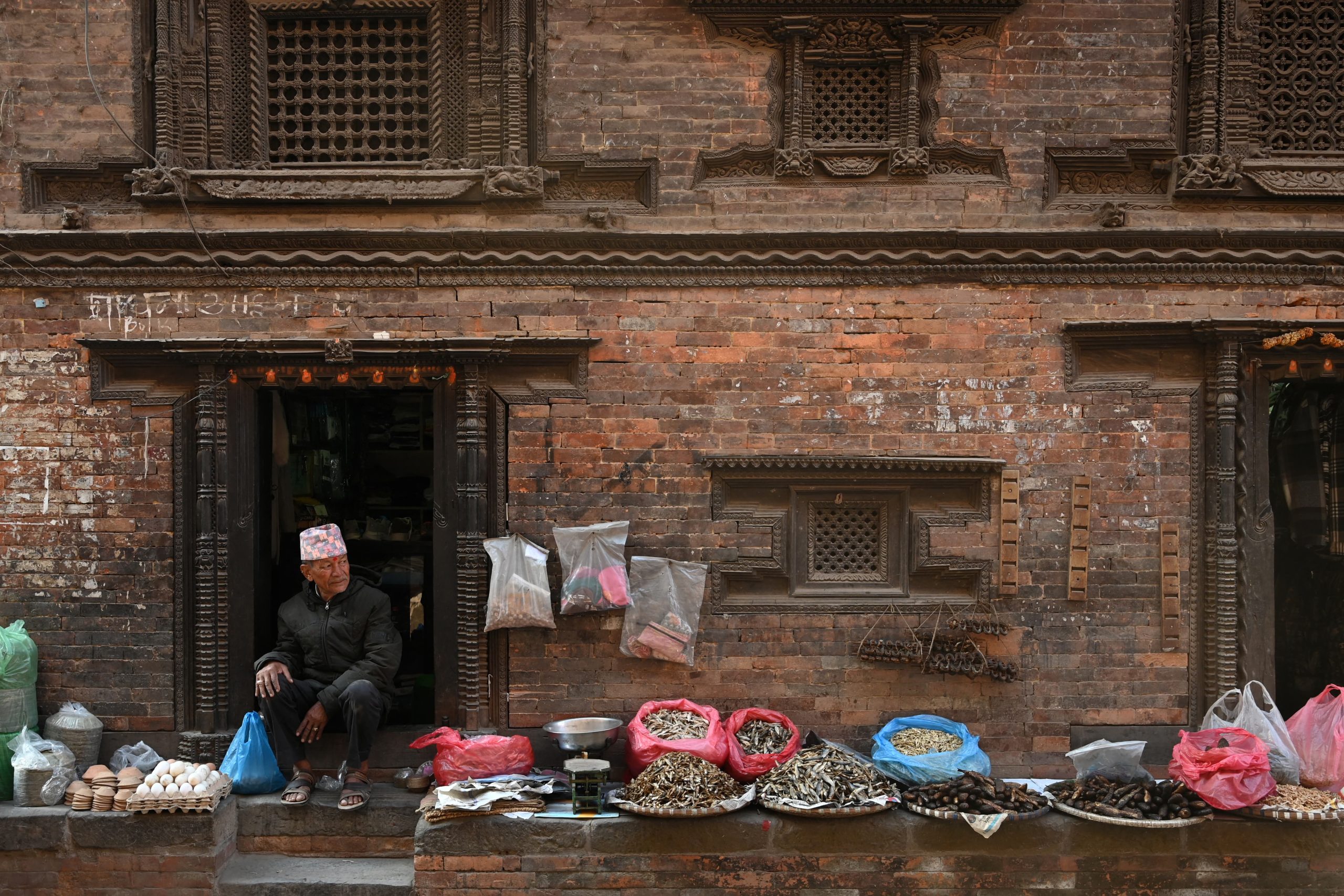
Politically, Nepal’s landscape remained discernibly fragile. When the national election in January 2024 failed to return any clear winner, another coalition government was eventually established six months later. A vendor selling dry fish waits for customers in Bhaktapur on March 14, 2024. Credit: Prakash Mathema / AFP
Fragile politics
Politically, Nepal’s landscape remained discernibly fragile. When the national election in January 2024 failed to return any clear winner, another coalition government was eventually established six months later. This followed outgoing prime minister Pushpa Kamal Dahal’s failed attempts to secure the trust of the House of Representatives. As a result, KP Sharma Oli of the Communist Party of Nepal (CPN) was again returned to power in July 2024 – his fourth as the country’s prime minister – in a coalition government with the centrist Nepali Congress.
Such fragile alliances combined with ongoing political instability in the country, including a resurgence of a pro-monarchy movement, continued to challenge legislative action in the country, including long awaited amendments to policies and laws related to the media.
Even still, the government’s intent to regulate social media has been criticised as heavy handed and intimidatory. On January 26, 2025, the Social Media Operation, Use and Regulation Bill, aimed at regulating social media was introduced in Parliament. While the intention behind the bill is supposedly to curb the misuse of social platforms, rights activists and press freedom advocates have raised concerns about certain provisions. They argue that the bill, rather than addressing misuse, threatens to undermine freedom of expression and press freedom. Journalist organisations, including IFJ affiliates have strongly opposed the draconian bill, warning that it could be used as a tool to suppress dissent and control online content, as it criminalises online expression with hefty fines and imprisonment.
The bill requires social media platforms to post up to USD 73,000 in fines if they do not comply with government rules, while a user disseminating content that is not in line with the provisions of the bill can be subject to up to five years of imprisonment and fine of up to USD 3,650. Critics have pointed out two major problems with the bill: first, the judicial authority entrusted to a government department under the Communication and Information Technology Ministry to punish platforms and users; and second, the vague terms of offences subject to subjective interpretations. These, the critics of the bill say, could be used as a tool to suppress critical or dissenting voices, punish press, and heavily curtail freedom of expression of the citizen. The analysis of the bill reveals that all offences, except one related to anonymous accounts will only create confusion and allow misuse.
UNESCO published an official review of the bill assessing its alignment with international human rights standards, including the principles outlined in UNESCO’s Guidelines for the Governance of Digital Platforms. The review highlights the importance of ensuring the bill reflects Nepal’s constitutional values and international commitments, and need to focus on fostering transparency, accountability, and a multi stakeholder approach to digital governance, ensuring that freedom of expression and access to information remain at the core of Nepal’s regulatory framework. The review points out many of the provisions of the bill that clearly contradict international standards.
The government’s intent to regulate social media has been criticised as heavy handed and intimidatory.
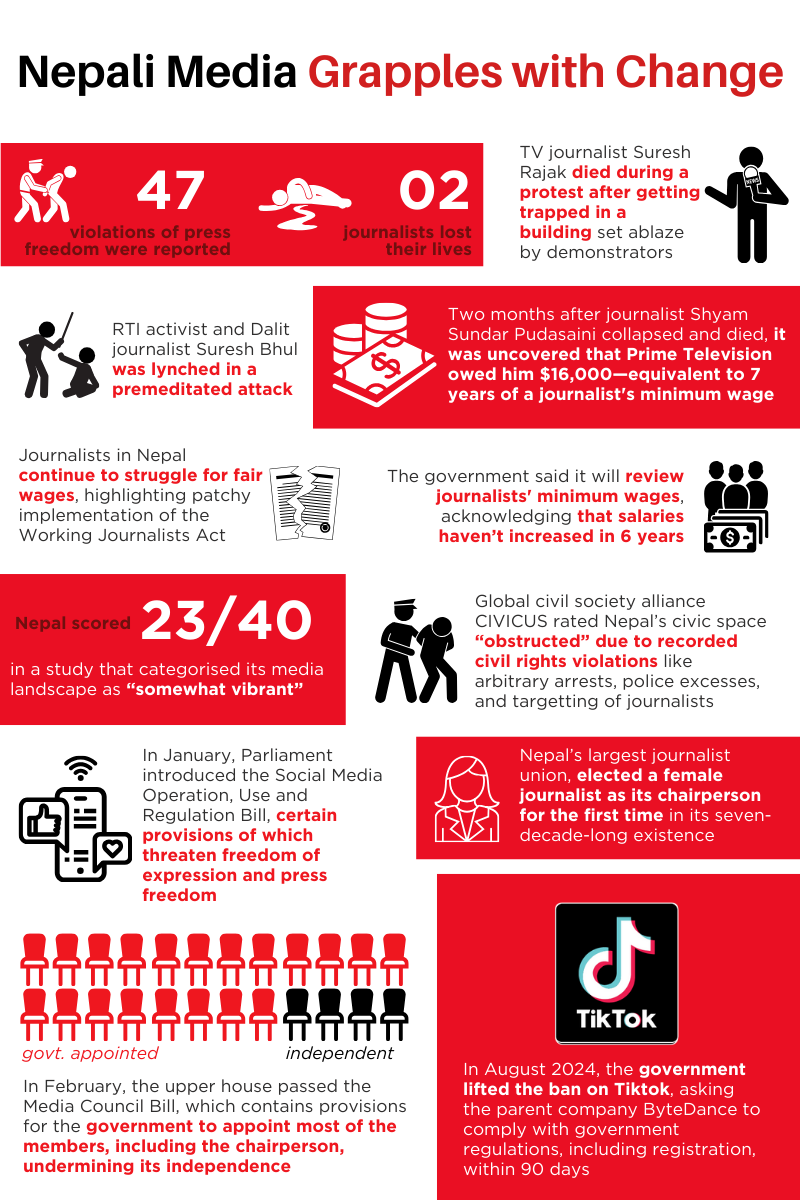

The safety and security of journalists in Nepal remains pressing as incidents of verbal and physical attacks on journalists continued unabated. Media workers continued to face threats, harassment, and violence from all sides – government employees, elected officials and private actors. The Federation of Nepali Journalists (FNJ) protest on March 30, 2025, following the killing of photojournalist Suresh Rajak during pro-monarchy protests in Kathmandu. Credit: FNJ / Facebook
Online controls
The hugely popular Chinese app TikTok was banned on November 2023 for allegedly causing “disruption to social harmony” when Pushpa Kamal Dahal ‘Prachanda’ of the Communist Party of Nepal-Maoist Center (CPN-Maoist) was the Prime Minister in the coalition government formed with the Communist Party of Nepal-Unified Marxist Leninist (CPN-UML). As the TikTok ban had been widely criticised, in August 2024, PM Oli’s cabinet decided to lift the ban, asking ByteDance, the company behind TikTok, to comply with government regulations, including registration, within 90 days. Alongside, the cabinet mooted laws to regulate social media.
The Media Council Bill, which was passed by the Upper House on February 10, 2025, though milder after the removal of provisions on fines and punishments for publishing offensive content, still contains problematic provisions that aim to regulate Nepali media. It has been opposed on grounds that it will affect rights and interests of journalists. The controversial provisions include the government’s direct role in appointment of most of the council members, including the chairperson, undermining its independence, and a requirement for media owners to disclose their sources of income and investments.
Another major development in the media sector in the period under review was the passage of the Public Service Broadcasting Bill in September 2024. It came into effect on November 8, 2024, merging state-owned Nepal Television and Radio Nepal under one umbrella, the National Public Service Broadcasting Agency. In December, former FNJ president Dr. Mahendra Bista was appointed as the first chairperson of the new entity, which represents a reform in the broadcasting sector that journalists’ unions have been demanding for more than two decades.
Death of two journalists
The year was marked by the deaths of two media workers in horrific circumstances. The first came a result of the resurgence of a pro-monarchist movement in the country, which included protests in March 2025 accompanied by widespread vandalism, destruction of government offices, shopping malls, media outlets and private houses.
Amid the protests, on March 28, 2025, Avenues TV’s Suresh Rajak, the head of the camera and video division, had climbed atop a tall building to cover a demonstration in the Tinkune area of Kathmandu. The demonstration subsequently turned violent, and protesters set the building alight, claiming it was being used by the police to launch tear gas shells. The photojournalist was unfortunately trapped on an upper floor of the burning building.
Rajak’s colleagues’ pleas for his rescue went unheeded and a fire truck that reached the venue was also vandalised by the protesters, forcing it to retreat without dousing the fire. Hours after Avenues Television reported Rajak missing, police recovered a body on the fourth floor of the building, burnt beyond recognition. Avenues TV then announced his death on air. He was one among two people killed during the violent protests during which demonstrators also vandalised the office of Kantipur Television and unsuccessfully tried to set the office of the Annapurna Post alight.
Audrey Azoulay, Director-General of UNESCO, condemned the killing of the photojournalist and called for a thorough investigation into the circumstances of his death and to ensure that the perpetrators are brought to justice.
On March 29, the Federation of Nepali Journalists (FNJ) issued a seven-day ultimatum to the government to the Home Minister, Ramesh Lekhak, to address demands related to attacks on journalists and media houses during the pro-monarchy protests. FNJ demanded compensation for the family of Suresh Rajak as well as for the media houses attacked by the protesters, including Kantipur Television and Annapurna Post.
Another journalist killed in 2024 was Suresh Bhul, a right-to-information activist and journalist from Kailali district who worked for Sudurpati.com. Bhul was beaten to death by a mob on November 11, 2024. An investigation into his killing by the National Dalit Journalists Association, Nepal, revealed that his death resulted from a premeditated attack connected to his reporting on public institutions and was not one of personal vendetta as earlier concluded. Bhul, a resident of Kantipur Tole, belonged to a marginalised caste and was joint secretary of the National Dalit Journalists’ Association.
The Media Council Bill, which was passed by the Upper House on February 10, 2025, though milder after the removal of provisions on fines and punishments for publishing offensive content, still contains problematic provisions that aim to regulate Nepali media.
On March 29, the Federation of Nepali Journalists (FNJ) issued a seven-day ultimatum to the government to the Home Minister, Ramesh Lekhak, to address demands related to attacks on journalists and media houses during the pro-monarchy protests.
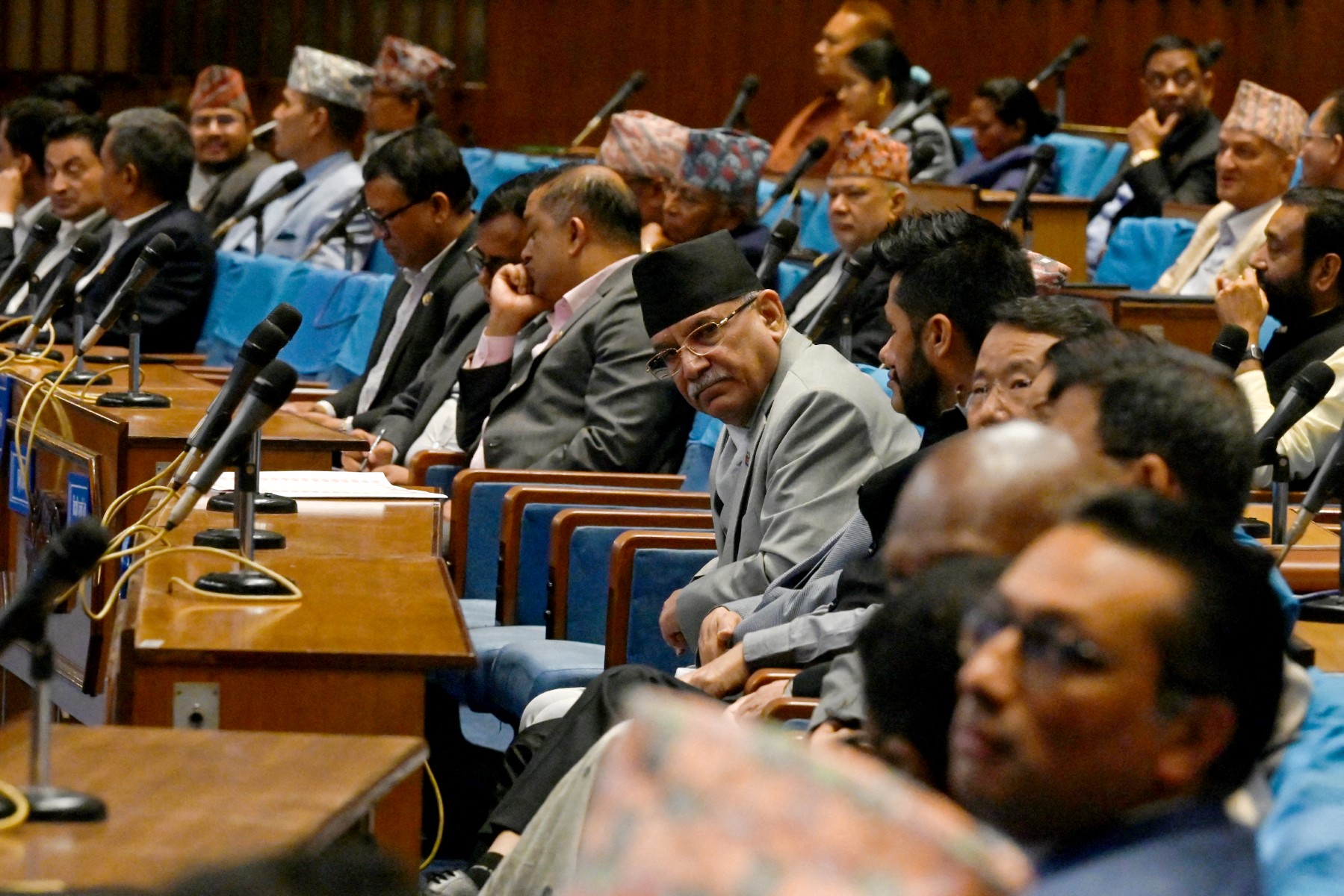
When Nepali Prime Minister Pushpa Kamal Dahal’s government coalition disintegrated and a new government was ushered in, the country’s ban on Chinese app TikTok was lifted in August 2024. Pushpa Kamal Dahal looks on during a parliament session in Kathmandu on July 12, 2024. Credit: Prakash Mathema / AFP
Working to death
Addressing a long-standing problem, the Minister for Communications and Information Technology, Prithvi Subba Gurung, indicated the government’s willingness to review the minimum wages of journalists, noting that the government was aware that salaries of working journalists had not been increased for the past six years.
In February 2025, speaking in a program organised by the Minimum Wages Fixation Committee, the minister also expressed readiness to amend the Working Journalists Act to increase the minimum wage of journalists and accepted the government’s failure to fully implement the Act. Indeed, bad working conditions in the media industry had literally become a matter of life and death in Nepal.
The untimely death of Shyam Sundar Pudasaini, 33, on January 3, 2025, was a clarion call to renew the struggle for decent work in the media industry. Pudasaini, the deputy editor of NepalViews.com collapsed after returning home from his office and was rushed to the hospital where he was pronounced dead on arrival. Pudasaini, who had been in journalism for 14 years, had worked for various media outlets, including Mountain Television, Himalaya Times daily, and Prime Television. He was known to be a fearless investigative journalist.
Two months after Pudasini’s death, the issue of non-payment of his salary despite court orders came to light. He had not received USD 16,000 (equivalent to seven years of the minimum wage of a journalist in Nepal) from Prime Television, a station run by well-known journalist Rishi Dhamala. Pudasaini had filed a case in court over the non-payment of wages and unlawful termination of employment, and the court had ordered the station to pay the amount and re-appoint him. However, the station had failed to pay him for at least a year. Only after the Working Journalists Union and Press Chautari threatened protests in March 2025 did the station reach an agreement with Pudasaini’s elder brother to pay the outstanding dues in instalments. There were also unverified reports that Pudasaini was sick just before his death but was unable to afford medical treatment.
Unabated attacks
The safety and security of journalists in Nepal remains a pressing issue, as incidents of verbal and physical attacks on journalists continued unabated. Journalists continued to face threats, harassment, and violence from all sides – government employees, elected officials (especially at the local levels) and also from private actors. Numerous cases of journalists being threatened, beaten, or attacked for reporting critical news have been recorded by FNJ, with some incidents escalating to fatal consequences. Despite the existence of mechanisms to address grievances over published news, the rising trend of attacks on journalists has left media and journalists concerned about the capacity of these mechanisms to adequately protect them has much broader implications for press freedom.
Journalists working in the country’s capital, Kathmandu, and particularly those in the districts, have been victims of freedom violations such as assault, abuse, threats, prohibition, and arrest while carrying out their duties. In December 2024, the mayor of Dharan in eastern Nepal, published a social media post threatening Gopal Dahal and an FNJ district president Janak Rishi Rai. The threats were allegedly a response to a news report conducted in association with the Center for Investigative Journalism (CIJ) that was critical of the municipality work and was published by HimalKhabar.com. Reacting to the news, Kathmandu’s mayor, who is known for his strong social media influence, demanded on Facebook that the journalists present themselves to him the next day, with threats to end their careers. After the mayor’s post, Dahal was subjected to online trolling by the politician’s followers.
Dahal was also threatened in another incident in January 2025 over another news story when the chairman of a private company abused him during a phone call and threatened to physically attack him.
Dirgharaj Upadhyay, editor of Paschim Today, was threatened and harassed through social media in February 2025 after an article was published that was critical of the mayor of Dhangadi Metropolitan. Upadhyay and his family were threatened through a fake account on social media.
Increased online threats and harassment of media workers have sadly not diminished the frequency of offline threats and harassment by a range of perpetrators including government officials.
In July 2024, provincial minister Rajiv Gurung, aka Deepak Manange, publicly threatened the Gandaki province chief of Online Khabar, Amrit Subedi, after the journalist published a photo of the shirtless minister in his office.
In a letter in December 2024, the District Administration Office of Dadeldhura in western Nepal instructed news portal, Simananews.com, to take down a news article. This followed publication of a news story about Chief District Officer, Chomendra Neupane, who was alleged to have misused the official letterhead and seal to issue orders to the media. When these orders were not followed, the highest-ranking government official in the district verbally threatened to arrest the journalists.
On July 2024, a person identifying himself as the secretariat secretary of the student organization of the Communist Party of Nepal (Biplov), Kapil C, threatened the editor-in-chief of Jana Aastha, Kishore Shrestha, with a physical attack over a news story. The threat against Shrestha, who is also a former acting chair of the Press Council of Nepal, includes details that they would “kill Shrestha and his wife wherever they are found” and “destroy their house with a bomb.”
Some physical attacks against media workers, though not definitively linked with their professional work, were alarming, and created a sense of fear and insecurity among the media community.
Lalit Bahadur Singh, reporter with national daily Nepal Samacharpatra, and also chairman of the FNJ Bajhang chapter, was stabbed with a knife by a group in February 2025. Singh was eating dinner at a hotel when the group asked him to come to a room for a talk and attacked him. The journalist suffered a deep wound on his forehead as a result of the attack, the motive for which remains unclear. An unidentified person also attacked Kamal Bahadur Bohara, editor of Palikasamaya.com, in Baneshwor, Kathmandu, for unknown reasons. Similarly, an unidentified person attacked Karana Media Online’s editor, Jagat Sapkota, in October 2024 while he was drinking a cup of coffee in Surkhet. The journalist required six stitches on his head during the attack.
Addressing a long-standing problem, the Minister for Communications and Information Technology, Prithvi Subba Gurung, indicated the government’s willingness to review the minimum wages of journalists.
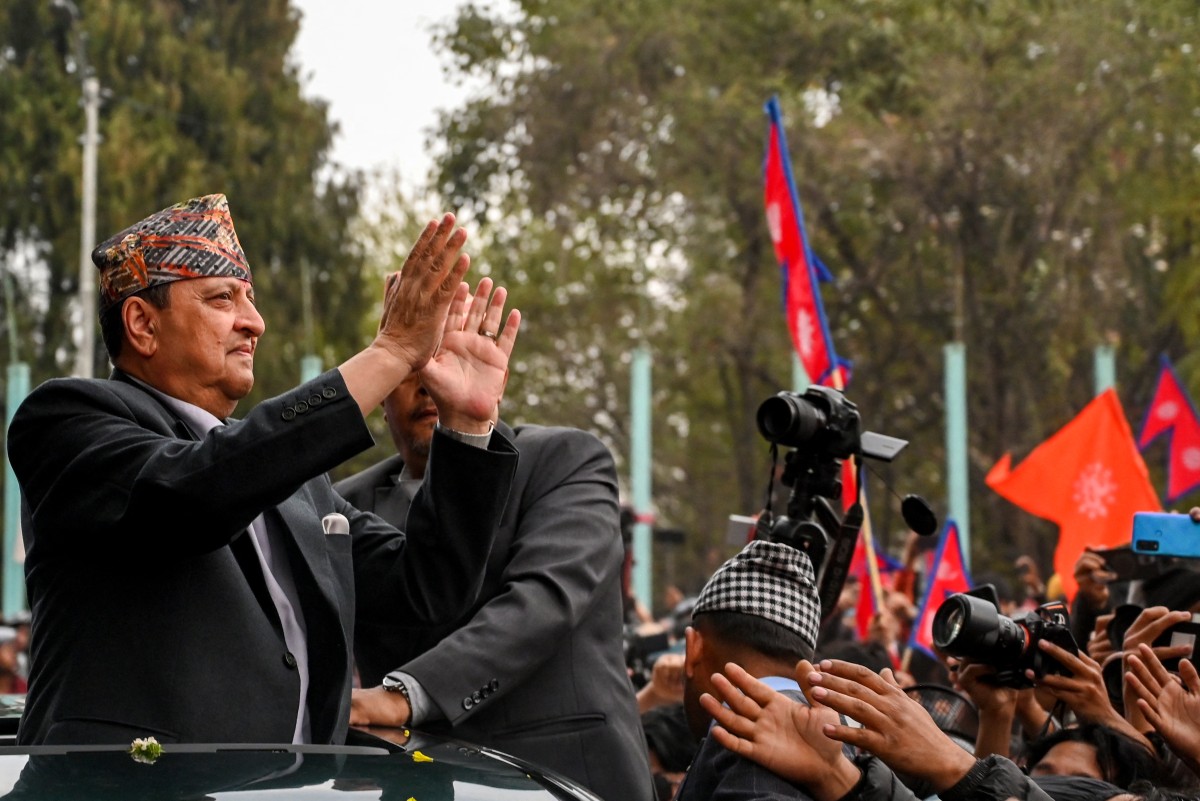
A revived pro-monarchist movement in the country saw protests unfold in March 2025 accompanied by widespread vandalism, destruction of government offices, shopping malls, media outlets and private houses. Nepal’s former King Gyanendra Bir Bikram Shah Dev arrives at Tribhuwan International Airport, Kathmandu, on March 9, 2025. Credit: Prakash Mathema / AFP
Long wait for truth and reconciliation
During its decade-long Maoist Civil War (1996-2006), Nepal witnessed killings of 23 journalists with nine of those killed after the 2006 Comprehensive Peace Accord that effectively ended the insurgency.
Although the killings of journalists have been well-documented, proper investigation and action against the perpetrators are still awaited. The perpetrators have not been identified in a majority of the cases, with industry sources reporting on the political reluctance to investigate such crimes. As such, the enduring legacy of the war and the climate of impunity for such crimes remains.
While Nepal’s parliament in August 2024 passed a bill to amend the Enforced Disappearance Enquiry, Truth and Reconciliation Commission Act, the amendment is unlikely to provide justice to the families of the killed journalists.
Along with some victims’ groups from the 1996-2006 insurgency, three international human rights organisations and the National Human Rights Commission expressed criticism of the provision that reduced 75 per cent sentencing, even in serious violations of human rights. Amnesty International, Human Rights Watch (HRW) and the International Commission of Jurists (ICJ) in a joint statement said that the law has several provisions that could undermine a successful outcome of the transitional justice processes, adding that the definition of serious violations of human rights is not consistent with international law and excludes other serious crimes.
High profile arrest
The arrest of Kailash Sirohiya, chairperson and owner of Nepal’s top media house, in May 2024 was a crucial event for press freedom. Sirohiya is a media tycoon in Nepal who owns two prominent national dailies, Kantipur and Kathmandu Post, as well as a radio station and a television station. Sirohiya was ostensibly arrested after an arrest warrant was issued by the District Court of Dhanusha over an investigation into his citizenship. However, underlying this action was the potential misuse of power by the then-deputy prime minister with the home affairs portfolio, Rabi Lamichhane.
The subject of Kantipur’s series of investigations into the cooperative scam, Lamichhane was accused of misappropriating millions of rupees deposited in various cooperatives in several cities, subsequently arrested and is currently facing numerous court cases.
During his arrest, Sirohiya denied all accusations against him and claimed that the arrest was an “act of vengeance” for Kantipur’s reporting on Home Minister Lamichhane. FNJ and NPU, along with numerous other human rights organisations, condemned the arrest as an attack on press freedom. On May 23, 31 editors of leading publications wrote to Prime Minister Pushpa Kamal Dahal, raising their concerns over the manner and timing of Sirohiya’s arrest and reaffirmed their commitment to fighting for press freedom.
Sirohiya was not the only publisher to face arrest from his office. Bijaya Sah, the publisher of Dastak Khabar, was arrested from the newspaper’s office in October 2024 over a news story. A police team arrested Sah after the newspaper published a story criticising obscene dances and disorderly conduct during an entertainment program organised at the famous Durga Temple in Lahan, Siraha, on the occasion of Nepal’s biggest festival, Dashain. He was released after two days without any charges, but the journalist said he was subjected of psychological torture.
The global civil society alliance CIVICUS rated the civic space in Nepal as ‘obstructed’ due to recorded violations of civil rights including arbitrary arrests, excessive use of force and targeting of journalists.
During his arrest, Sirohiya denied all accusations against him and claimed that the arrest was an “act of vengeance” for Kantipur’s reporting on Home Minister Lamichhane.
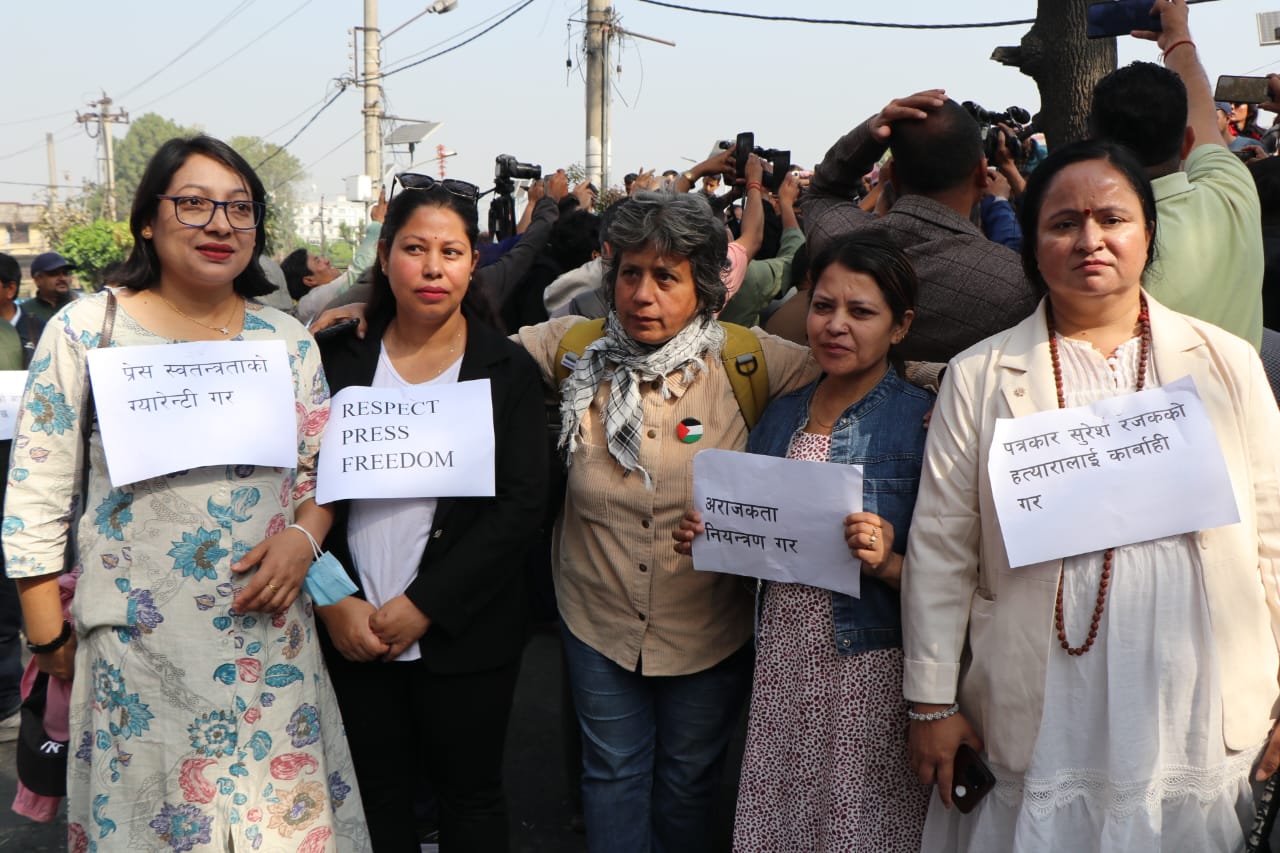
Over the past year, the FNJ recorded a total of 47 incidents of press freedom violations, including the killing of two journalists. Credit: FNJ / Facebook
Women rise
Making history, the FNJ, Nepal’s largest journalist union, elected a female journalist as its chairperson for the first time in its seven-decade-long existence. Nirmala Sharma, supported by two large journalist unions, including another IFJ affiliate, the Nepal Press Union (NPU), was elected by the annual general assembly in December 2024. It is also notable that the assembly and elections were held under the leadership of another woman journalist, Vice-President Bala Adhikari.
The women’s councils of FNJ and NPU have been actively raising issues of women journalists and putting then on the forefront, and several of these programs continued in 2024. The FNJ’s central women’s committee has been actively lobbying for women journalists’ rights and safety. In an International Women’s Day observance on March 5, 2024, the committee organised an all-stakeholder day-long program on ‘Nepali Media in Gender Issues’ in collaboration with the Minimum Wage Fixation Committee, which is also led by former FNJ executive committee member Sangita Khadka. The committee also organised an interaction on the state and challenges of women journalists in Nepal on August 30, 2024. NPU organised an interaction on increasing women’s participation in journalism on March 6, 2024.
Conclusion
The media industry and working journalists in Nepal have still not been able to recover from the economic crisis. As the economic downturn caused by the COVID-19 pandemic continues, it seems that the wage problems for working journalists have increased. Amid job precarity, the government has registered bills in parliament that raised concerns of violation the freedom of expression of the general public and press freedom. Journalist unions and rights organisations have opposed those bills demanding overhauls, but the government’s response has been that of defiance.
Attacks against journalists, which continued through the year, were accompanied by a lack of prosecution of perpetrators. There is dissatisfaction with the official avenues to pursue complaints, making the pursuit of justice even more challenging. Unless trust is built in mechanisms of redress, impunity for crimes against journalists is only likely to be further entrenched.
